


Hard water -- formation of chalk on boiling
In this experiment it is nicely demonstrated what happens when so-called hard water (which contains a lot of calcium ions and bicarbonate ions) is boiled for some time. Everyone knows the formation of chalk, which covers heating spirals, glass walls and many other things and every few months needs to be removed.
The mechanism behind the formation of chalk from hard water is the decomposition of bicarbonate ions when the water is boiled, and the subsequent precipitation of carbonate ions with calcium and magnesium ions, which also are present in the water.
![]()
![]() Required
chemicals:
Required
chemicals:
-
sodium bicarbonate
-
calcium chloride
-
phenolphtalein pH indicator solution
![]() Required
equipment:
Required
equipment:
- test tubes
![]() Safety:
Safety:
- Besides the heating of the test tubes, no real risk is involved in this experiment.
![]() Disposal:
Disposal:
- No toxic chemicals are used in this experiment, the waste can be flushed down the drain.
![]()
Rise of pH when boiling a solution of sodium bicarbonate
This experiment is very simple. Dissolve some sodium bicarbonate in cold distilled water and add a few drops of phenolphtalein indicator. The solution of sodium bicarbonate is very slightly basic. The phenolphtalein indicator solution has a faint pink color.
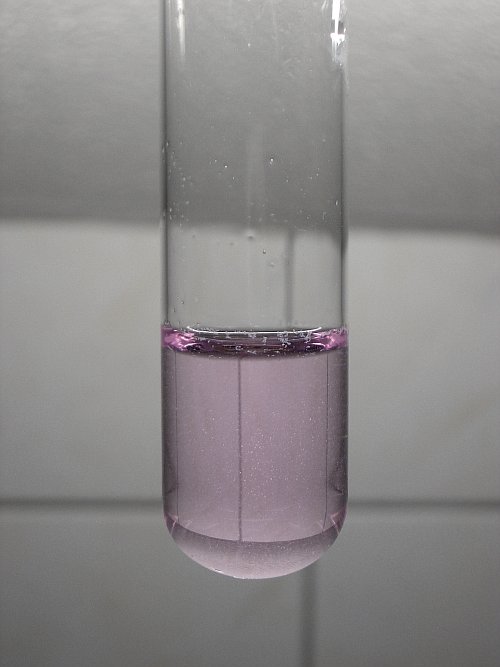
When this solution is boiled for a while, then the color of the solution becomes much more intense. This means that the pH of the solution is rising considerable, well beyond the trajectory where phenolphtalein changes from colorless to red/purple. The solution remains deep red/purple after cooling down again.
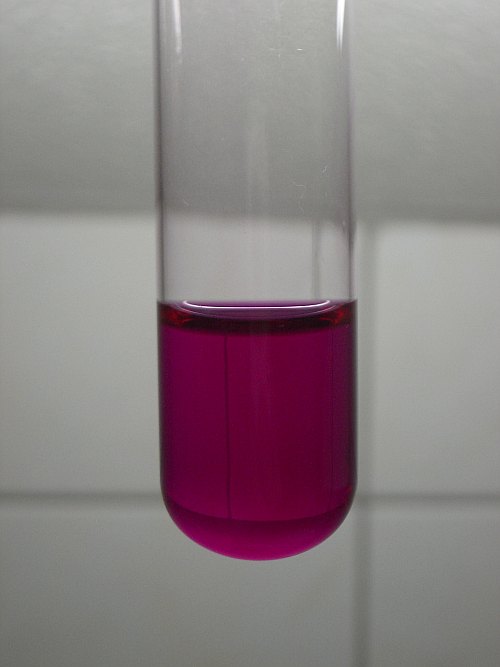
This experiment demonstrates that the pH is going up when a solution of bicarbonate is heated. The chemical explanation is given at the end of this web page.
![]()
Formation of chalk from hard water
In this experiment some very hard water is made and then this is boiled. Making the very hard water can be done as follows:
- Take a few ml of distilled water and put this in a wide test tube.
- Add a few mm3 of solid NaHCO3. Swirl the test tube, until all of the solid has dissolved. Only take a small amount, just a few mm3 of the powder, not more.
- Dissolve some calcium chloride in another test tube with distilled water and add this solution to the solution of NaHCO3.
The solution is clear and colorless, as shown in the picture below.
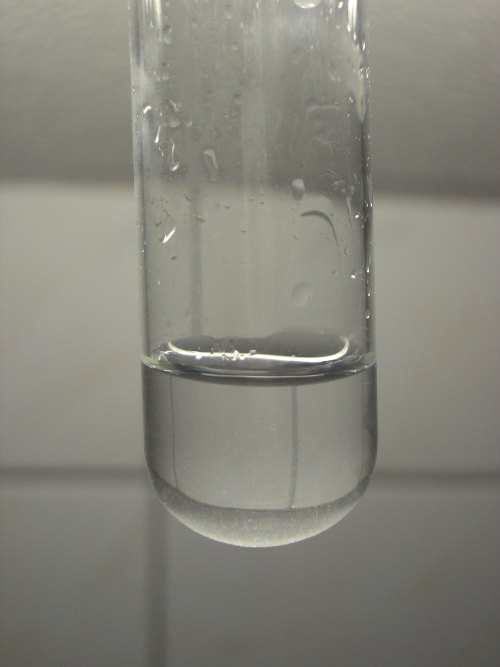
This colorless solution is heated and the liquid is kept boiling for a few minutes. After the boiling, the liquid looks as follows:
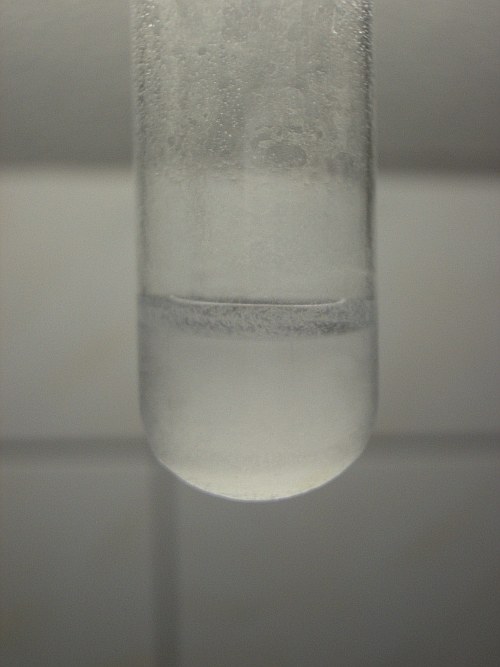
Many small solid particles are formed, which tend to stick to the glass and the liquid becomes turbid. Carefully letting settle the solid at the bottle and rinsing along the glass with the liquid above the precipitate results in a small, but clearly visible concentration of white solid at the bottom. Also some solid remains stuck on the glass walls.
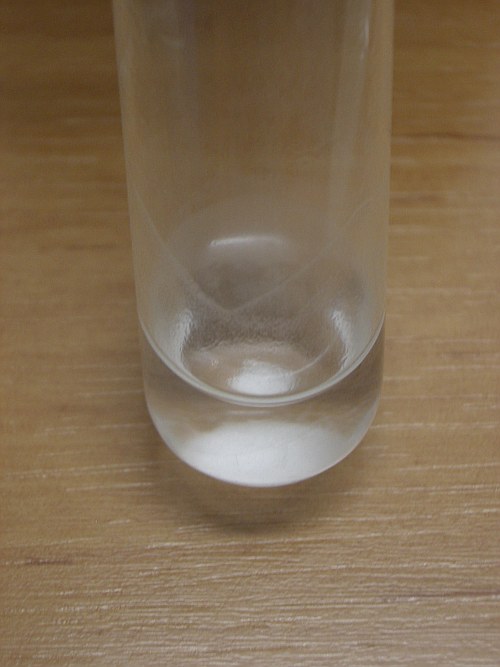
![]()
Discussion of results
Hard water contains a high concentration of the following ion:
- Ca2+ (and possibly Mg2+)
- HCO3–
In the first experiment, a solution of NaHCO3 is prepared. This solution is very slightly alkaline, almost neutral. In such a solution the following equilibrium exists (which is largely to the left):
(1) HCO3– + H2O ↔ H2CO3 + OH–
There also is another set of equilibria in this solution, which also are largely to the left:
(2) HCO3– + H2O ↔ CO32– + H3O+
(3) HCO3– + OH– ↔ CO32– + H2O
This latter two equilibria are less pronounced than the previous one, and this makes a solution of a bicarbonate slightly alkaline.
The compound H2CO3 is a weak acid, but more important is that it is in equilibrium as follows:
(4) H2CO3 ↔ CO2 + H2O
At room temperature, the CO2 remains in solution. When the solution is heated, then the CO2 becomes less soluble and escapes from the solution as a gas and equilibrium (4) now becomes a reaction which is driven much more to the right:
(4') H2CO3 → CO2↑ + H2O
Because H2CO3 is taken away from the system, equilibrium (1) also is driven to the right, resulting in the following:
(1') HCO3– + H2O → CO2↑ + H2O + OH–
With the rising concentration of the hydroxide ion, equilibrium (3) is driven more to the right as well, because CO32– is only a fairly weak base and even low concentrations of OH– drive this to the right. Free H2CO3 becomes less abundant and the reaction in which CO2 is formed comes to a halt. At a certain point, when there hardly is any bicarbonate left, which is the case after a few minutes of boiling, the situation has changed drastically. The main species in solution now is carbonate. Approximately half of the carbon is driven out as CO2 and the remaining half is present as carbonate, which is in equilibrium with a small amount of hydroxide and bicarbonate. The pH of the solution has risen considerably, because now the main species is CO32– and although this only is a fairly weak base, it is a much stronger base than bicarbonate.
The first experiment demonstrates what is explained above.
Presence of calcium ions
When calcium ions are present in solution, then the calcium ions are precipitated as calcium carbonate. Calcium bicarbonate is soluble in water fairly well, but calcium carbonate has very low solubility. So, the carbonate, which results from heating the solution with the bicarbonate, causes precipitation of calcium (and magnesium) ions.
On heating, the net reaction is
Ca2+ + 2HCO3– → CaCO3↓ + CO2↑ + H2O
This effect is demonstrated in the second experiment.